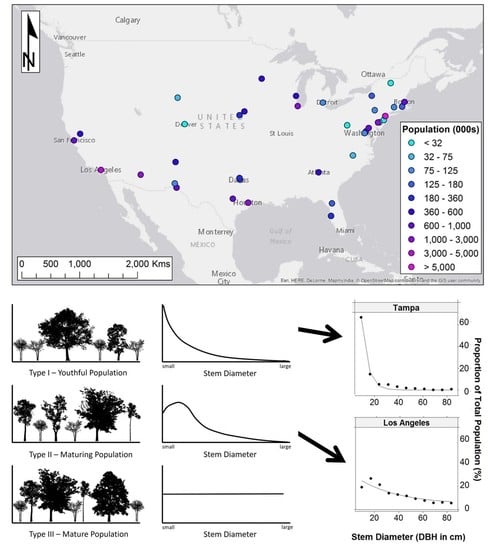DBH Distributions in America’s Urban Forests—An Overview of Structural Diversity
Abstract
1. Introduction
2. Materials and Methods
2.1. Study Sites
2.2. Data
2.3. Analysis—Diameter Distributions and Shannon–Wiener Diversity Index
3. Results
3.1. Urban Forest Diameter Class Distributions
3.2. A Comparison of Diameter Class Distributions Against Ideal Distributions
3.3. Structural Diversity Index
4. Discussion
4.1. Diameter Class Distributions in Context
4.2. Stable or Expanding Urban Tree Populations?
4.3. Policy, Planning, and Management Implications of Structural Diversity
4.4. Functional Implications of Structural Diversity
4.5. Study Limitations
5. Conclusions
Author Contributions
Funding
Acknowledgments
Conflicts of Interest
References
- Roman, L.A.; McPherson, E.G.; Scharenbroch, B.C.; Bartens, J. Identifying common practices and challenges for local urban tree monitoring programs across the United States. Arboric. Urban For. 2013, 39, 292–299. [Google Scholar]
- Buongiorno, J.; Dahir, S.; Lu, H.-C.; Lin, C.-R. Tree size diversity and economic returns in uneven-aged forest stands. For. Sci. 1994, 40, 83–103. [Google Scholar]
- Maco, S.E.; McPherson, E.G. A practical approach to assessing structure, function, and value of street tree populations in small communities. J. Arboric. 2003, 29, 84–98. [Google Scholar]
- Kowarik, I. Novel urban ecosystems, biodiversity, and conservation. Environ. Pollut. 2011, 159, 1974–1983. [Google Scholar] [CrossRef]
- Nowak, D.J.; Aevermann, T. Tree compensation rates: Compensating for the loss of future tree values. Urban For. Urban Green. 2019, 41, 93–103. [Google Scholar] [CrossRef]
- Koeser, A.; Hauer, R.; Norris, K.; Krouse, R. Factors influencing long-term street tree survival in Milwaukee, WI, USA. Urban For. Urban Green. 2013, 12, 562–568. [Google Scholar] [CrossRef]
- Nowak, D.J.; Hoehn, R.E., III; Crane, D.E.; Stevens, J.C.; Leblanc Fisher, C. Assessing Urban Forest Effects and Values, Chicago’s Urban Forest; Resource Bulletin NRS-37; U.S. Department of Agriculture, Forest Service, Northern Research Station: Newtown Square, PA, USA, 2010; 27p.
- Welch, J.M. Street and park trees of Boston: A comparison of urban forest structure. Landsc. Urban Plan. 1994, 29, 131–143. [Google Scholar] [CrossRef]
- McPherson, E.G.; Rowntree, R.A. Using Structural Measures to Compare Twenty-Two U.S. Street Tree Populations. Landsc. J. 1989, 8, 13–23. [Google Scholar] [CrossRef]
- McPherson, E.G.; van Doorn, N.; de Goede, J. Structure, function and value of street trees in California, USA. Urban For. Urban Green. 2016, 17, 104–115. [Google Scholar] [CrossRef]
- Millward, A.A.; Sabir, S. Structure of a forested urban park: Implications for strategic management. J. Environ. Manag. 2010, 91, 2215–2224. [Google Scholar] [CrossRef]
- De Liocourt, F. De l’amenagement des Sapinières. Bulletin Trimestriel-Société Forestière de Franche-Comté et Belfort 1898, 4, 396–409. [Google Scholar]
- McCarthy, J.W.; Weetman, G. Age and size structure of gap-dynamic, old-growth boreal forest stands in Newfoundland. Silva Fenn. 2006, 40, 209–230. [Google Scholar] [CrossRef]
- Nowak, D.; Hoehn, R.; Bodine, A.; Greenfield, E.; O’Neil-Dunne, J. Urban forest structure, ecosystem services and change in Syracuse, NY. Urban Ecosyst. 2016, 19, 1455–1477. [Google Scholar] [CrossRef]
- Richards, N.A. Diversity and stability in a street tree population. Urban Ecol. 1983, 7, 159–171. [Google Scholar] [CrossRef]
- Kottek, M.; Grieser, J.; Beck, C.; Rudolf, B.; Rubel, F. World map of the Köppen-Geiger climate classification updated. Meteorol. Z. 2006, 15, 259–263. [Google Scholar] [CrossRef]
- Rubel, F.; Brugger, K.; Haslinger, K.; Auer, I. The climate of the European Alps: Shift of very high resolution Köppen-Geiger climate zones 1800–2100. Meteorol. Z. 2017, 26, 115–125. [Google Scholar] [CrossRef]
- U.S. Census Bureau. SUB-EST2014: Subcounty Resident Population Estimates: April 1, 2010 to July 1, 2014; U.S. Census Bureau: Suitland, MD, USA, 2015.
- USDA Forest Service. i-Tree Eco Field Guide v6.0. 2019. Available online: https://www.itreetools.org/tools/i-tree-eco (accessed on 22 January 2020).
- Morgenroth, J.; Östberg, J. Measuring and Monitoring Urban Trees and Urban Forests. In Routledge Handbook of Urban Forestry; Ferrini, F., van den Konijnendijk Bosch, C., Fini, A., Eds.; Routledge: New York, NY, USA, 2017; pp. 33–48. [Google Scholar]
- Roman, L.A.; Scharenbroch, B.C.; Östberg, J.P.; Mueller, L.S.; Henning, J.G.; Koeser, A.K.; Sanders, J.R.; Betz, D.R.; Jordan, R.C. Data quality in citizen science urban tree inventories. Urban For. Urban Green. 2017, 22, 124–135. [Google Scholar] [CrossRef]
- R Core Team. R: A Language and Environment for Statistical Computing; R Foundation for Statistical Computing: Vienna, Austria, 2019. [Google Scholar]
- Pohlert, T. The Pairwise Multiple Comparison of Mean Ranks Package. 2014. Available online: https://cran.r-project.org/ (accessed on 22 January 2020).
- Engmann, S.; Cousineau, D. Comparing distributions: The two-sample Anderson-Darling test as an alternative to the Kolmogorov-Smirnoff test. J. Appl. Quant. Methods 2011, 6, 1–17. [Google Scholar]
- Kendal, D.; Dobbs, C.; Lohr, V.I. Global patterns of diversity in the urban forest: Is there evidence to support the 10/20/30 rule? Urban For. Urban Green. 2014, 13, 411–417. [Google Scholar] [CrossRef]
- McElhinny, C.; Gibbons, P.; Brack, C.; Bauhus, J. Forest and woodland stand structural complexity: Its definition and measurement. For. Ecol. Manag. 2005, 218, 1–24. [Google Scholar] [CrossRef]
- Spellerberg, I.F.; Fedor, P.J. A tribute to Claude Shannon (1916–2001) and a plea for more rigorous use of species richness, species diversity and the ‘Shannon–Wiener’Index. Glob. Ecol. Biogeogr. 2003, 12, 177–179. [Google Scholar] [CrossRef]
- Oksanen, J.; Blanchet, F.G.; Kindt, R.; Legendre, P.; Minchin, P.R.; O’Hara, R.B.; Simpson, G.L.; Solymos, P.; Stevens, M.H.H.; Wagner, H. Vegan: Community Ecology Package. R Package Version 2.3-0. 2015. Available online: https://cran.r-project.org/ (accessed on 22 January 2020).
- Nowak, D.J. Contrasting natural regeneration and tree planting in fourteen North American cities. Urban For. Urban Green. 2012, 11, 374–382. [Google Scholar] [CrossRef]
- Pearce, L.M.; Kirkpatrick, J.B.; Davison, A. Using size class distributions of species to deduce the dynamics of the private urban forest. Urban For. Urban Green. 2013, 39, 74–84. [Google Scholar]
- Pincetl, S. Implementing municipal tree planting: Los Angeles million-tree initiative. Environ. Manag. 2010, 45, 227–238. [Google Scholar] [CrossRef] [PubMed]
- Campbell, L.K. Constructing New York City’s urban forest. The politics and governance of the MillionTreesNYC campaign. In Sandbergl. Anders; Bardekjianadrina; Buttsadiaeds. Urban For. Trees Greenspace. A Policy Perspective; Routledge: New York, NY, USA, 2014; Chapter 16; pp. 242–260. [Google Scholar]
- Danford, R.S.; Cheng, C.; Strohbach, M.W.; Ryan, R.; Nicolson, C.; Warren, P.S. What Does It Take to Achieve Equitable Urban Tree Canopy Distribution? A Boston Case Study. Cities Environ. (Cate) 2014, 7, 2. [Google Scholar]
- Locke, D.H.; Grove, J.M.; Galvin, M.; O’Neil-Dunne, J.P.; Murphy, C. Applications of urban tree canopy assessment and prioritization tools: Supporting collaborative decision making to achieve urban sustainability goals. Cities Environ. (Cate) 2013, 6, 7. [Google Scholar]
- Ordóñez, C.; Duinker, P.N. An analysis of urban forest management plans in Canada: Implications for urban forest management. Landsc. Urban Plan. 2013, 116, 36–47. [Google Scholar] [CrossRef]
- Kenney, W.A.; van Wassenaer, P.J.E.; Satel, A.L. Criteria and indicators for strategic urban forest planning and management. Arboric. Urban For. 2011, 37, 108–117. [Google Scholar]
- Roy, S.; Byrne, J.; Pickering, C. A systematic quantitative review of urban tree benefits, costs, and assessment methods across cities in different climatic zones. Urban For. Urban Green. 2012, 11, 351–363. [Google Scholar] [CrossRef]
- Noss, R.F. Indicators for Monitoring Biodiversity: A Hierarchical Approach. Conserv. Biol. 1990, 4, 355–364. [Google Scholar] [CrossRef]
- Miller, R.W.; Hauer, R.J.; Werner, L.P. Urban Forestry: Planning and Managing Urban Greenspaces, 3rd ed.; Waveland Press: Long Grove, IL, USA, 2015. [Google Scholar]
- McHale, M.; Burke, I.; Lefsky, M.; Peper, P.; McPherson, E. Urban forest biomass estimates: Is it important to use allometric relationships developed specifically for urban trees? Urban Ecosyst. 2009, 12, 95–113. [Google Scholar] [CrossRef]
- Troxel, B.; Piana, M.; Ashton, M.S.; Murphy-Dunning, C. Relationships between bole and crown size for young urban trees in the northeastern USA. Urban For. Urban Green. 2013, 12, 144–153. [Google Scholar] [CrossRef]
- Gilman, E.F. Effect of nursery production method, irrigation, and inoculation with mycorrhizae-forming fungi on establishment of Quercus virginiana. J. Arboric. 2001, 27, 30–39. [Google Scholar]
- Morgenroth, J.; Santos, B.; Cadwallader, B. Conflicts between landscape trees and lawn maintenance equipment—The first look at an urban epidemic. Urban For. Urban Green. 2015, 14, 1054–1058. [Google Scholar] [CrossRef]
- McPherson, E.G.; Kotow, L. A municipal forest report card: Results for California, USA. Urban For. Urban Green. 2013, 12, 134–143. [Google Scholar] [CrossRef]
- Millenium Ecosystem Assessment. Ecosystems and Human Well-Being: Synthesis; Island Press: Washington, DC, USA, 2005. [Google Scholar]
- USDA Forest Service. i-Tree Eco User’s Manual v6.0. 2019. Available online: https://www.itreetools.org/tools/i-tree-eco (accessed on 22 January 2020).
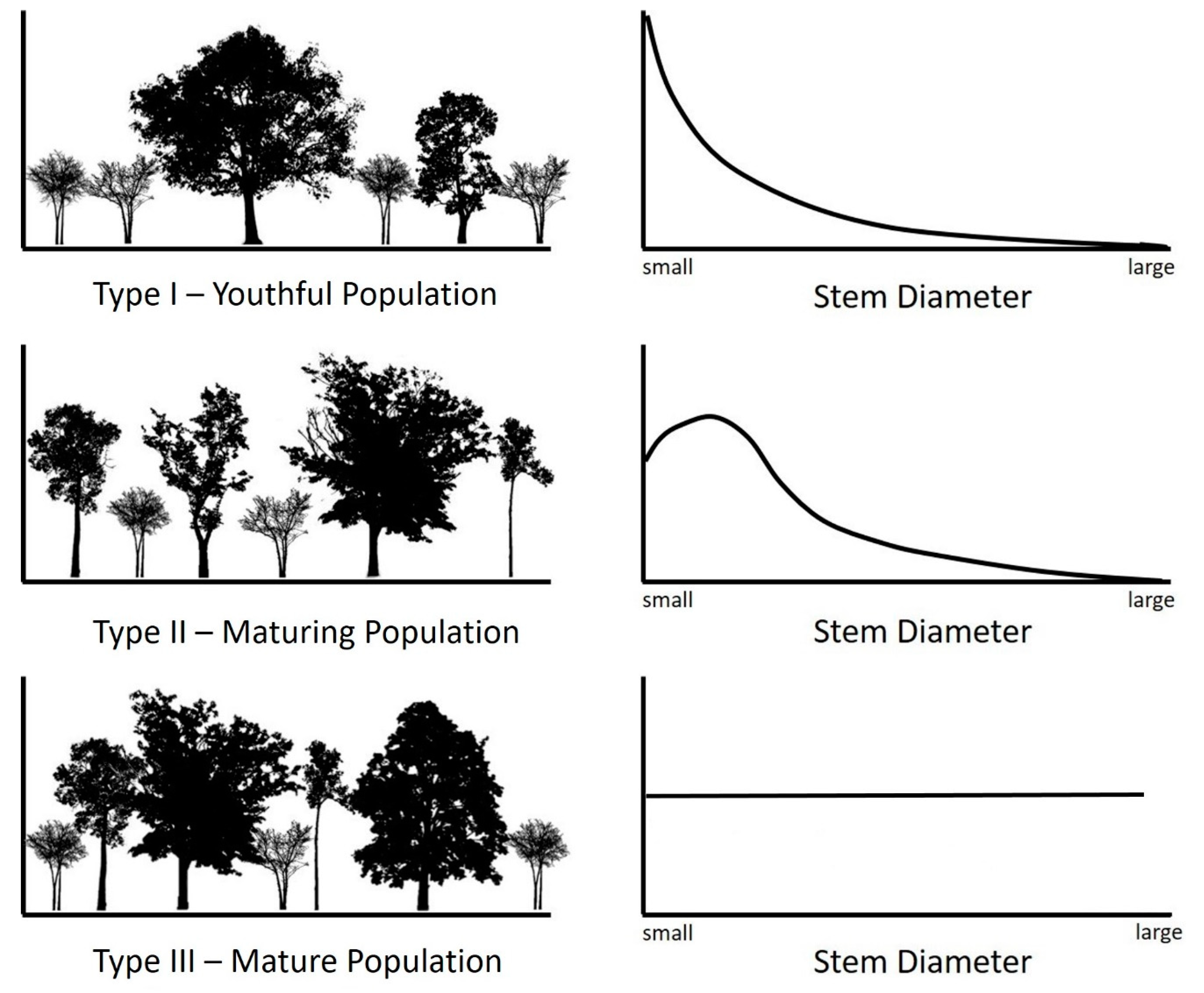
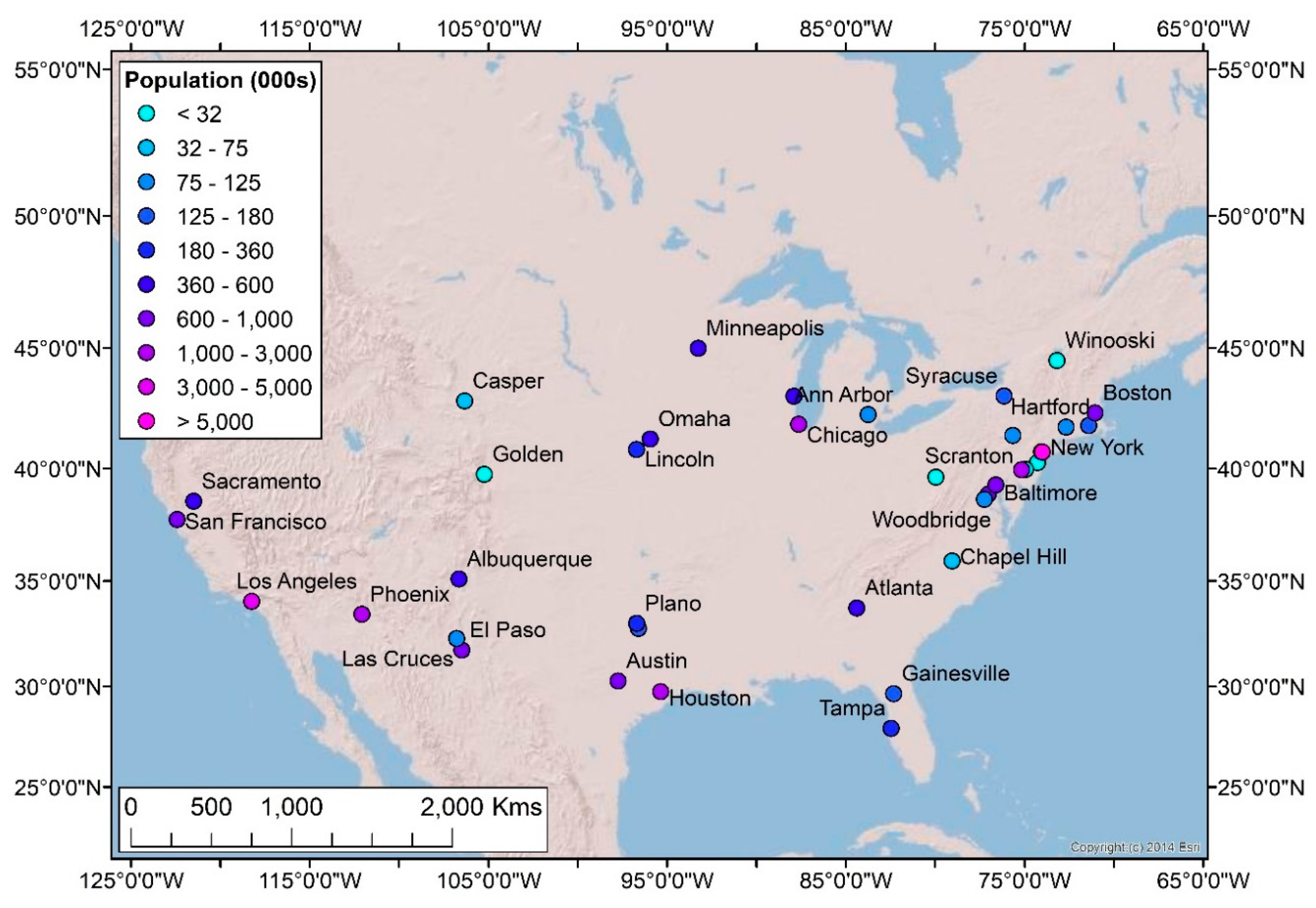
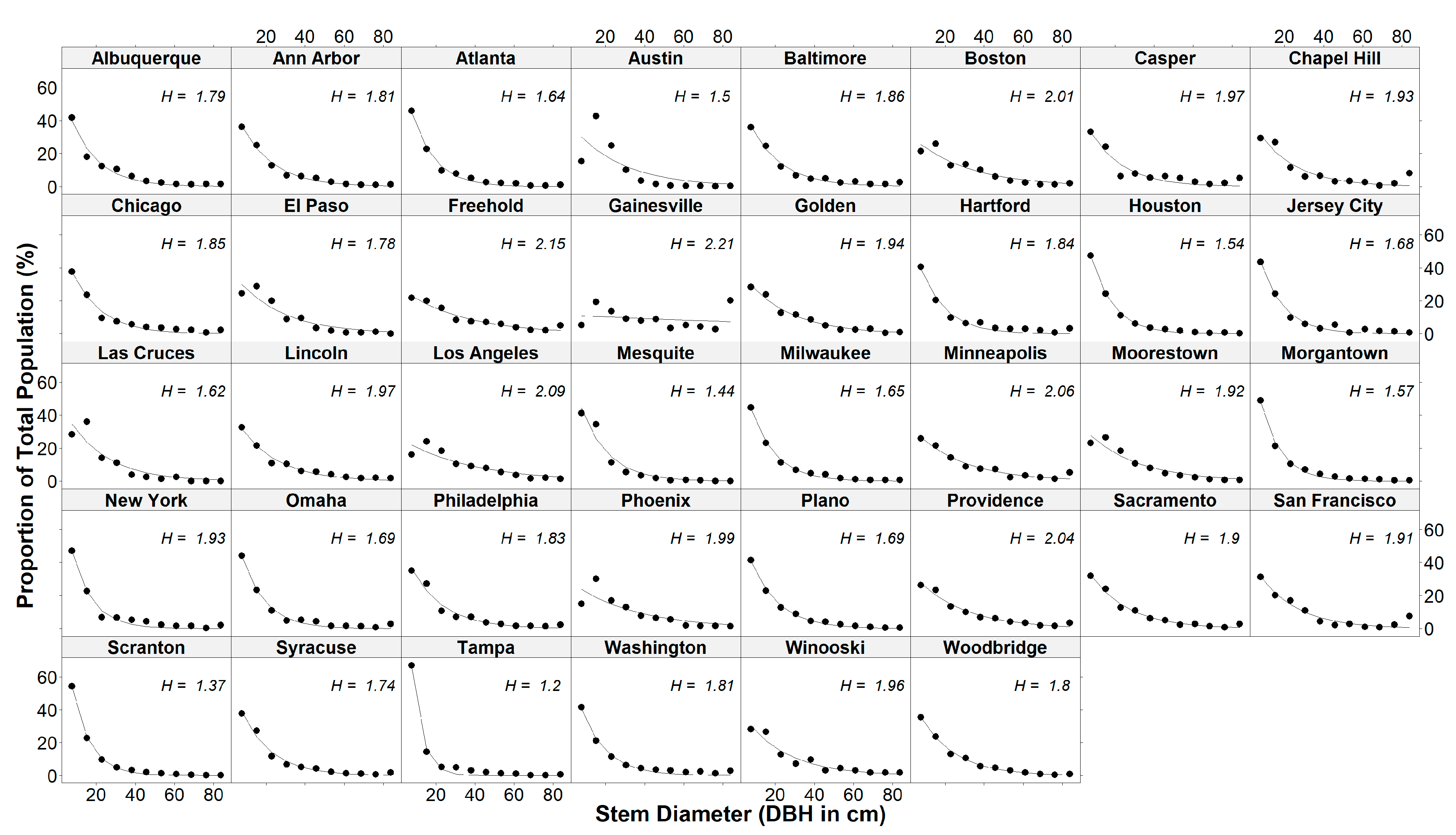
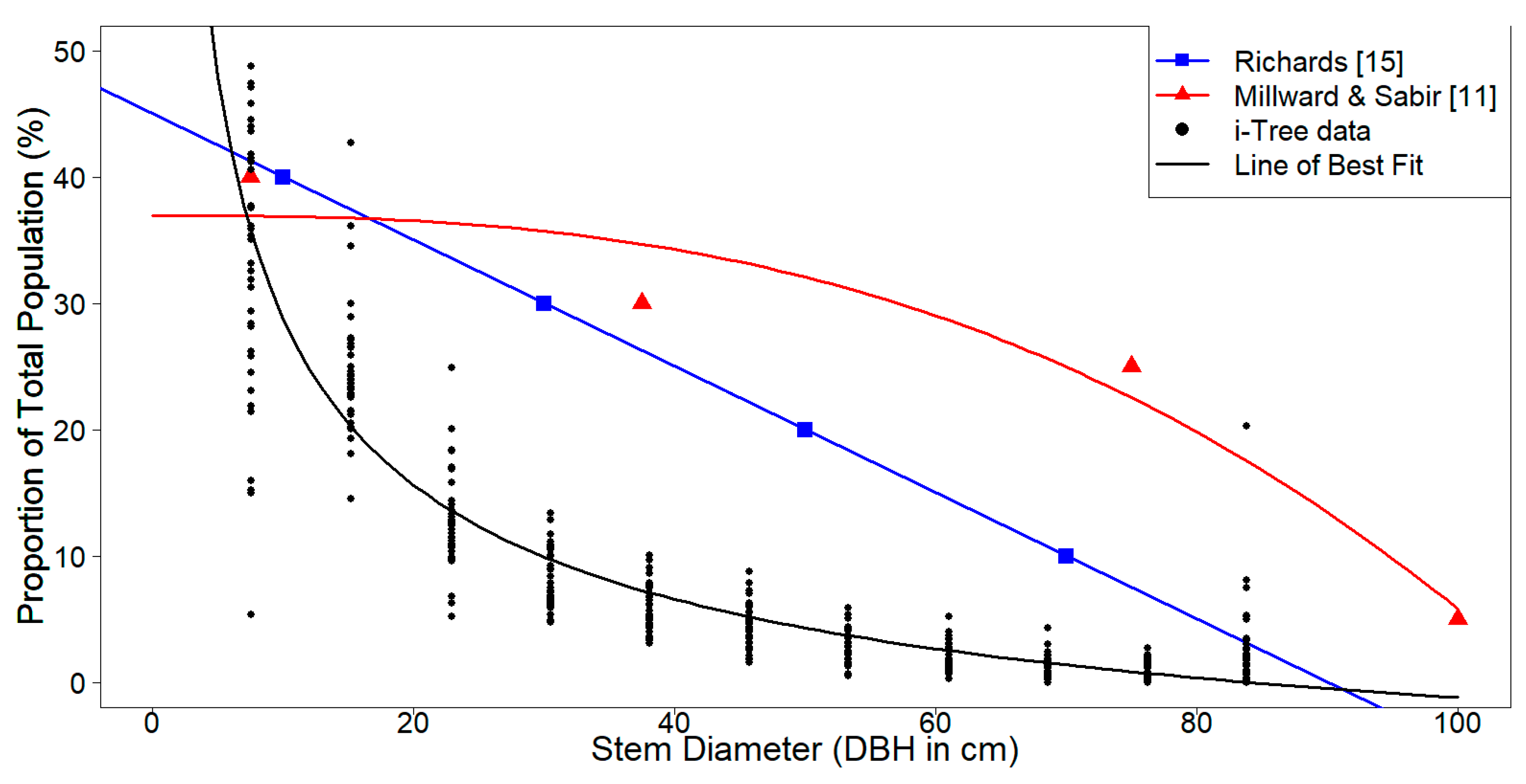
| City | State | USDA Plant Hardiness Zone | Köppen-Geiger Climate Classification | US Census Population Estimate (2014) | Year of i-Tree Eco Assessment | # Sample Plots | # Sampled Trees |
|---|---|---|---|---|---|---|---|
| Albuquerque | New Mexico | 7b | BSk | 557,169 | 2013 | 199 | 421 |
| Ann Arbor | Michigan | 6a | Dfa | 117,770 | 2013 | 201 | 1596 |
| Atlanta | Georgia | 7b | Cfa | 456,002 | 1997 | 205 | 2402 |
| Austin | Texas | 8b | Cfa | 912,791 | 2014 | 206 | 2027 |
| Baltimore | Maryland | 7a | Cfa | 622,793 | 2009 | 195 | 1030 |
| Boston | Massachusetts | 5b | Cfa | 655,884 | 1996 | 217 | 930 |
| Casper | Wyoming | 4a | BSk | 60,086 | 2006 | 234 | 235 |
| Chapel Hill | N. Carolina | 7b | Cfa | 59,376 | 2012 | 80 | 2950 |
| Chicago | Illinois | 5b | Dfa | 2,722,389 | 2007 | 745 | 1697 |
| El Paso | Texas | 8a | BWh | 679,036 | 2014 | 201 | 279 |
| Freehold | New Jersey | 6b | Cfa | 11,973 | 1998 | 144 | 626 |
| Gainesville | Florida | 8b | Cfa | 128,460 | 2007 | 93 | 1335 |
| Golden | Colorado | 5a | Dfb | 20,201 | 2007 | 115 | 194 |
| Hartford | Connecticut | 6a | Cfa | 124,705 | 2007 | 200 | 791 |
| Houston | Texas | 8b | Cfa | 2,239,558 | 2015 | 200 | 731 |
| Jersey City | New Jersey | 6b | Cfa | 262,146 | 1998 | 220 | 341 |
| Las Cruces | New Mexico | 8a | BWk | 101,408 | 2014 | 205 | 224 |
| Lincoln | Nebraska | 5b | Dfa | 272,996 | 2008/09 | 178 | 573 |
| Los Angeles | California | 10b | Csb | 3,928,864 | 2007/08 | 348 | 681 |
| Mesquite | Texas | 8a | Cfa | 144,416 | 2012 | 225 | 1591 |
| Milwaukee | Wisconsin | 5b | Dfa | 599,642 | 2008 | 216 | 1084 |
| Minneapolis | Minnesota | 4a | Dfa | 407,207 | 2004 | 110 | 278 |
| Moorestown | New Jersey | 6b | Cfa | 20,594 | 2000 | 206 | 1690 |
| Morgantown | West Virginia | 6a | Cfa | 31,073 | 2004 | 136 | 1295 |
| New York | New York | 6b | Cfa | 8,491,079 | 1996 | 206 | 643 |
| Omaha | Nebraska | 5a | Dfa | 446,599 | 2008/09 | 189 | 1005 |
| Philadelphia | Pennsylvania | 7b | Cfa | 1,560,297 | 1996 | 210 | 1433 |
| Phoenix | Arizona | 9b | BWh | 1,537,058 | 2017 | 204 | 263 |
| Plano | Texas | 8a | Cfa | 278,480 | 2014 | 225 | 828 |
| Providence | Rhode Island | 6a | Cfa | 179,154 | 2013 | 250 | 860 |
| Sacramento | California | 9b | Csa | 485,199 | 2007 | 300 | 637 |
| San Francisco | California | 10a | Csb | 852,469 | 2004 | 194 | 478 |
| Scranton | Pennsylvania | 6a | Dfb | 75,281 | 2006 | 182 | 1798 |
| Syracuse | New York | 5a | Dfb | 144,263 | 2009 | 198 | 1499 |
| Tampa | Florida | 9b | Cfa | 358,699 | 2011 | 201 | 1642 |
| Washington | D.C. | 7a | Cfa | 658,893 | 2004 | 201 | 976 |
| Winooski | Vermont | 5a | Dfb | 7228 | 2014 | 63 | 529 |
| Woodbridge | New Jersey | 7a | Cfa | 100,824 | 2000 | 215 | 1284 |
© 2020 by the authors. Licensee MDPI, Basel, Switzerland. This article is an open access article distributed under the terms and conditions of the Creative Commons Attribution (CC BY) license (http://creativecommons.org/licenses/by/4.0/).
Share and Cite
Morgenroth, J.; Nowak, D.J.; Koeser, A.K. DBH Distributions in America’s Urban Forests—An Overview of Structural Diversity. Forests 2020, 11, 135. https://doi.org/10.3390/f11020135
Morgenroth J, Nowak DJ, Koeser AK. DBH Distributions in America’s Urban Forests—An Overview of Structural Diversity. Forests. 2020; 11(2):135. https://doi.org/10.3390/f11020135
Chicago/Turabian StyleMorgenroth, Justin, David J. Nowak, and Andrew K. Koeser. 2020. "DBH Distributions in America’s Urban Forests—An Overview of Structural Diversity" Forests 11, no. 2: 135. https://doi.org/10.3390/f11020135
APA StyleMorgenroth, J., Nowak, D. J., & Koeser, A. K. (2020). DBH Distributions in America’s Urban Forests—An Overview of Structural Diversity. Forests, 11(2), 135. https://doi.org/10.3390/f11020135






